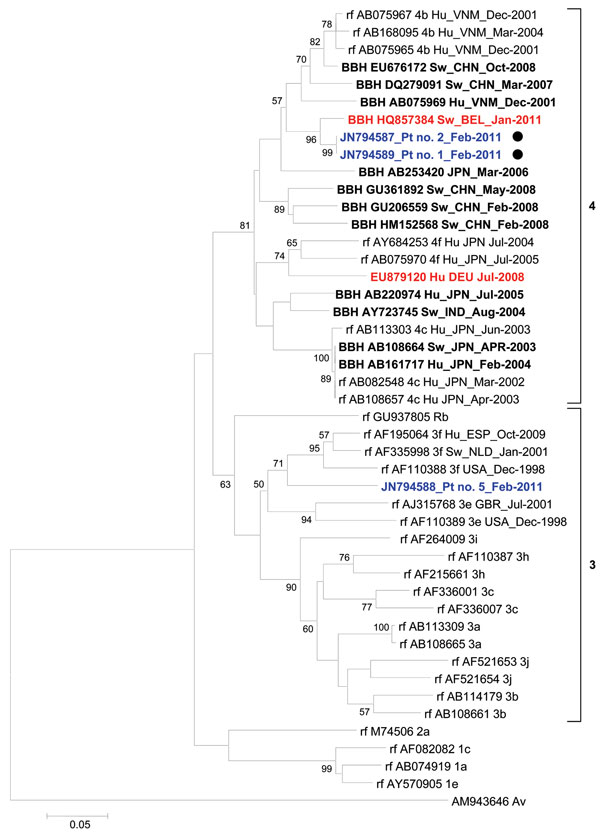Volume 18, Number 8—August 2012
Dispatch
Autochthonous Infections with Hepatitis E Virus Genotype 4, France
Figure

Figure. . Phylogenetic tree based on partial (186 nt) sequence of the 5′ end of open reading frame 1 of the hepatitis E virus (HEV) genome (nt 133–318; GenBank accession no. AB291961). Boldface indicates sequence with the highest BLAST scores (http://blast.ncbi.nlm.nih.gov/Blast.cgi); red (italics) indicates sequences obtained from a swine in Belgium with HEV genotype 4 (8) and a human in Germany with autochthonous HEV infection (9); blue (underlining) indicates sequences obtained from humans in Marseille, France, during January–March 2011; black dots indicate patients who ate uncooked pig liver sausage. Reference sequences (rf) with known genotypes and subtypes are indicated (6). Numbers on right indicate genotype. For sequences from this study, nucleotide alignments were performed by using ClustalX version 2.0 (www.clustal.org/download/current). The tree was constructed by using MEGA4 (www.megasoftware.net) and the neighbor-joining method as described (2). Branches were obtained from 1,000 resamplings of the data; those with bootstrap values >50% are labeled on the tree. The avian HEV sequence AM943646 was used as an outgroup. Scale bar indicates nucleotide substitutions per site. HEV sequences are labeled with GenBank accession number, host, country where isolated, and collection or submission date. Hu, human; VNM, Vietnam; BBH, best BLAST hit; Sw, swine; CHN, China; BEL, Belgium; Pt, patient; JPN, Japan; DEU, Germany; IND, India; Rb, rabbit; ESP, Spain; NLD, the Netherlands; USA, United States; GBR, United Kingdom; Av, avian.
References
- Purdy MA, Khudyakov YE. The molecular epidemiology of hepatitis E virus infection. Virus Res. 2011;161:31–9. DOIPubMedGoogle Scholar
- Colson P, Borentain P, Queyriaux B, Kaba M, Moal V, Gallian P, Pig liver sausage as a source of hepatitis E virus transmission to humans. J Infect Dis. 2010;202:825–34. DOIPubMedGoogle Scholar
- Bouquet J, Tessé S, Lunazzi A, Eloit M, Rose N, Nicand E, Close similarity between sequences of hepatitis E virus recovered from humans and swine, France, 2008–2009. Emerg Infect Dis. 2011;17:2018–25. DOIPubMedGoogle Scholar
- Mansuy JM, Bendall R, Legrand-Abravanel F, Sauné K, Miédouge M, Ellis V, Hepatitis E virus antibodies in blood donors, France. Emerg Infect Dis. 2011;17:2309–12. DOIPubMedGoogle Scholar
- Legrand-Abravanel F, Mansuy JM, Dubois M, Kamar N, Peron JM, Rostaing L, Hepatitis E virus genotype 3 diversity, France. Emerg Infect Dis. 2009;15:110–4. DOIPubMedGoogle Scholar
- Lu L, Li C, Hagedorn CH. Phylogenetic analysis of global hepatitis E virus sequences: genetic diversity, subtypes and zoonosis. Rev Med Virol. 2006;16:5–36. DOIPubMedGoogle Scholar
- Parola P, Colson P, Dubourg G, Million M, Charrel R, Minodier P, Letter to the Editor. Group A streptococcal infections during the seasonal influenza outbreak 2010/11 in South East England. Euro Surveill. 2011;16:pii=19816.PubMedGoogle Scholar
- Hakze-van der Honing RW, van Coillie E, Antonis AF, van der Poel WH. First isolation of hepatitis E virus genotype 4 in Europe through swine surveillance in the Netherlands and Belgium. PLoS ONE. 2011;6:e22673. DOIPubMedGoogle Scholar
- Wichmann O, Schimanski S, Koch J, Kohler M, Rothe C, Plentz A, Phylogenetic and case–control study on hepatitis E virus infection in Germany. J Infect Dis. 2008;198:1732–41. DOIPubMedGoogle Scholar
- Erker JC, Desai SM, Mushahwar IK. Rapid detection of hepatitis E virus RNA by reverse transcription–polymerase chain reaction using universal oligonucleotide primers. J Virol Methods. 1999;81:109–13. DOIPubMedGoogle Scholar
- Renou C, Pariente A, Cadranel JF, Nicand E, Pavio N. Clinically silent forms may partly explain the rarity of acute cases of autochthonous genotype 3c hepatitis E infection in France. J Clin Virol. 2011;51:139–41. DOIPubMedGoogle Scholar
- Shata MT, Navaneethan U. The mystery of hepatitis E seroprevalence in developed countries: is there subclinical infection due to hepatitis E virus? Clin Infect Dis. 2008;47:1032–4. DOIPubMedGoogle Scholar
- Davern TJ, Chalasani N, Fontana RJ, Hayashi PH, Protiva P, Kleiner DE, Acute hepatitis E infection accounts for some cases of suspected drug-induced liver injury. Gastroenterology. 2011;141:1665–72. DOIPubMedGoogle Scholar
- Fu H, Wang L, Zhu Y, Geng J, Li L, Wang X, Analysing complete genome sequence of swine hepatitis E virus (HEV), strain CHN-XJ-SW13 isolated from Xinjiang, China: putative host range, and disease severity determinants in HEV. Infect Genet Evol. 2011;11:618–23. DOIPubMedGoogle Scholar
- Rolfe KJ, Curran MD, Mangrolia N, Gelson W, Alexander GJ, L'Estrange M, First case of genotype 4 human hepatitis E virus infection acquired in India. J Clin Virol. 2010;48:58–61. DOIPubMedGoogle Scholar